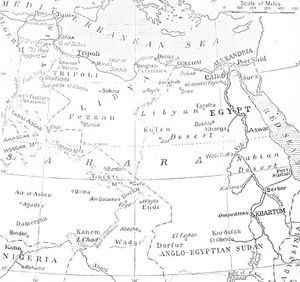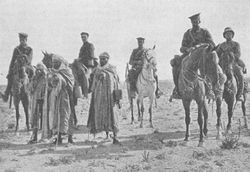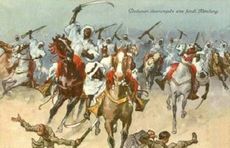معركة وادي مجيد
| معركة وادي مجيد | |||||
|---|---|---|---|---|---|
| جزء من حملة السنوسية | |||||
 منطقة عمليات الحملة السنوسية. | |||||
| |||||
| المتحاربون | |||||
|
|
| ||||
| القادة والزعماء | |||||
|
السيد أحمد الشريف، جعفر پاشا |
و. إ. پايتون أ. والاس هنري لوكين هـ. و. هودجتون | ||||
معركة وادي مجيد، هي جزء من حملة السنوسية، التي وقعت في شمال أفريقيا، من نوفمبر 1915 حتى فبراير 1917 أثناء الحرب العالمية الأولى. كانت الحملة بين بين الامبراطورية البريطانية، إيطاليا، والسنوسيين، طائفة دينية تضم رجال القبائل في ليبيا، بدعم من الدولة العثمانية والامبراطورية الألمانية. (قوات الامبراطورية البرياطنية كانت تشمل قوات من بريطانيا، جنوب أفريقيا، أستراليا ونيوزيلانديا، وهنود سيخ.)[1] أقنعت الدولة العثمانية زعيم السنوسيين، السنوسي الكبير أحمد الشريف السنوسي، في صيف 1915، بأن يأمر رجاله بالهجوم على مصر الواقعة تحت الاحتلال البريطاني من الغرب، إعلان الجهاد، وتشجيع التمردات ضد البريطانين في مصر. أقنعت الدولة العثمانية السيد أحمد بالهجوم، لأنها كانت تعتقد أن ذلك سيزيد من فرصة العثمانيين في الإستيلاء على قناة السويس من الشرق. عبر السنوسيين الحدود الليبية المصرية في نوفمبر 1915.
خطط السنوسيون لثلاث حملات في مناطق مختلفة ضد البريطانيين. الحملة الأولى وقعت على إمتداد الساحل المصري. في هذه الحملة، والتي بدأت في نوفمبر 1915، انسحبت القوات البريطانية في البداية لكنها بعد ذلك هزمت السنوسيين في اشتباكات مختلفة، منها معركة أجاجيا، وإستردوها، بمساعدة تعزيزات جنوب أفريقية، وفقدت جميع الأراضي المصرية على الساحل بحلول مارس 1916. كانت حملة 'عصابة الواحات' آخر مواجهة تم صدها.
مقدمة
قبل 1906، عندما اشترك السنوسيين في مقاومة الفرنسيين، كانوا قد أصبحوا "الطائفة الدينية السلمية نسبياً في الصحراء الغربية، المعارضة للتعصب". عندما غزا الإيطاليون ليبيا عام 1911، واحتلوا الساحل، قاومهم السنوسيين من المناطق الداخلية للبلاد. أثناء مقاومتهم للإيطاليين، حافظ السنوسيين على علاقات صداقة مع البريطانين في مصر. أعلنت المملكة المتحدة الحرب على الدولة العثمانية في 5 نوفمبر وشجع قادة الدولة العثمانية السنوسيين على الهجوم على مصر من الغرب. أراد العثمانيون من السنوسيين القيام بعمليات على الدفاعات الخلفية لقناة السويس. فشل العثمانيون في هجماتهم السابقة على القوات البريطانية من سيناء إلى الشرق وأرادوا مهاجمة هذه القوات من الاتجاه المعاكس. بحلول نوفمبر 1915، كانت قوة التواجد البريطاني في مصر قد انخفضت، لأن الجنود تم نقلهم من مصر لاستخدامهم في گاليپولي وبلاد الرافدين. الحدود الغربية لمصر كانت تحت حماية حرس السواحل المصري.
في صيف 1915، القوافل الأمنية التركية، وتشمل نوري باي، الأخ غير الشقيق لأنور پاشا وجعفر پاشا، عربي بغدادي في صفوف الجيش العثماني، والذي سيصبح فيما بعد قائد القوات السنوسية المقاتلة في الحملة الساحلية، ناقش اتفاقية مع السنوسي الكبير السيد أحمد الشريف، زعيم السنوسيين، للهجوم على البريطانيين في مصر من الغرب. لم يكن قراره مؤيداً من كل السنوسيين. وفر العثمانيون المدافع الآلية، المدافع، باستخدام سفن وفيما بعد غواصات ألمانية لتوصيل الأسلحة والأموال للسنوسيين.[2]
المعركة
Bad weather now prevented operations for ten days and during this time the 1st Battalion, New Zealand Rifle Brigade arrived to join the WFF. Meanwhile British aerial reconnaissance reported that the enemy was concentrating 900 Muhafizia in three battalions, plus four mountain guns and two machine guns, six miles south-west of Matruh where Jebel (mountain) Medwa dominated the road to Sollum. General Wallace hoped to surprise the enemy force, and at 05.00 hrs on 25th December two columns moved out from Matruh. [3]
The southern composite cavalry column under Brigadier Tyndale-Biscoe detoured on a southern loop through Wadi Toweiwa, attempting to position itself to prevent an enemy withdrawal. The infantry column, comprising the 15th Sikhs, 1st N.Z. Rifle Brigade and 2/8th Middlesex, plus supporting arms, advanced down the Sollum road. General Wallace’s headquarters followed the infantry column. The only effective signaling sub-unit in the force was the 15th Sikhs signals platoon. Lieut.-Colonel Gordon, who had asked to command his battalion rather than do a job that General Wallace could easily manage, was ordered to command the infantry column. Major G. Pennefather-Evans commanded the 15th Sikhs. As dawn broke, an enemy outpost spotted the British advance and gave the alarm by lighting a huge bonfire.
Observing that Jebel Medwa was not occupied, Gordon sent one of the two 15th Sikh companies forming the advanced guard to seize the Jebel, and this was achieved without opposition. At around 08.00 hrs an enemy mountain gun began to shell the road from a ridge west of Jebel Medwa where the enemy battalions were forming up. This caused the 15th Sikhs to open out into artillery (i.e. dispersed) formation, astride of but well clear of the road. With Lieut.-Colonel Gordon using his telescope and acting as an observer, the Notts Battery engaged and silenced the enemy gun from a range of 2,000 yards, whilst shells from HMS Clematis also fell on the enemy-occupied ridge from a range of 10,000 yards.
Lieut-Colonel Gordon requested General Wallace to relieve the Sikh company on Jebel Medwa, and a company of the Middlesex did this. The 15th Sikhs now advanced on the enemy ridge on a frontage of 200 yards, with the 1st New Zealand Rifles following. Companies of New Zealanders were placed as guards on each flank as the Sikhs moved briskly across an open plateau. The advance was halted 800 yards from the enemy to allow the cavalry to appear and take up position. As the cavalry did not appear, the advance continued but now with both New Zealand companies on the right flank. As the British troops moved onto the ridge the enemy broke and fled, some of them hiding in caves and gullies where they were shot or bayoneted. The whole of the ridge was secured by 10.00 hrs. Gordon now brought the guns forward onto the plateau where they fired into the retreating enemy. Regrettably the cavalry was not in position to complete the destruction of the Muhafizia battalions.
The southern column had first been delayed by moving its guns over difficult terrain, and then had been engaged at around 08.00 hours by enemy camelry and horsed cavalry who had anticipated the British cavalry move. Although machine gun fire finally dispersed the enemy, this contact disrupted the column’s advance. At 15.00 hrs the cavalry column appeared but by then the battle was nearly over. The enemy had retreated into Wadi Majid followed by the Sikhs and New Zealanders. The enemy camp in the wadi was set alight and the Muhafizia rearguard, demoralized but still fighting effectively, was driven onto the beach. Some of the enemy feigned death or wounds, but then opened fire at close range. This so enraged the Sikhs that any of these men taken alive were thrown into the burning tents.
The light was fading and at 17.00 hrs Colonel Gordon broke off the infantry pursuit, ordering the battalions to bivouac on Jebel Medwa. The mounted troops returned to Matruh that night, followed by the infantry early the next morning, 26th December. British losses had been thirteen killed and fifty-one wounded. The Senussi’s force lost between 300 and 400 dead, and eighty prisoners were taken.
النتائج
The Senussi and his followers continued to present a security threat in the Western Desert for a further twelve months. But the participation of the 15th Sikhs in the campaign was over, as the regiment now received orders to proceed to India. The 15th Sikhs had borne the brunt of the fighting so far, and had provided the backbone for a very untrained, inexperienced and under-staffed Western Frontier Force. The regiment had acquitted itself with distinction, and for its services in this theatre it received the honour ‘Egypt 1915-17.’ As a result of the post-war reforms of the Indian Army, it became the 2nd Battalion, 11th Sikh Regiment. ___________
انظر أيضاً
المصادر
- ^ Richard, J (9 September 2007), Senussi Uprising, 1915–1917, Military History Encyclopedia on the Web, http://www.historyofwar.org/articles/wars_senussi_uprising.html
- ^ Evans-Pritchard 1954, p. 121
- ^ The Egyptian Western Desert, November 1915 to February 1916, kaiserscross.com
المراجع
- Russell McGuirk, The Sanusi’s Little War
- The 15th Sikhs War Diary (copy kindly provided by Russell McGuirk)
- Lieut.-General Sir George Macmunn & Captain Cyril Falls, Official History of the War, Military Operations Egypt and Palestine, from the outbreak of war with Germany to June 1917
- Field Marshall Lord Carver, The National Army Museum Book of the Turkish Front 1914-18
- Peter Duckers, Reward of Valor, The Indian Order of Merit 1914-1918
- Rana Chhina, The Indian Distinguished Service Medal


